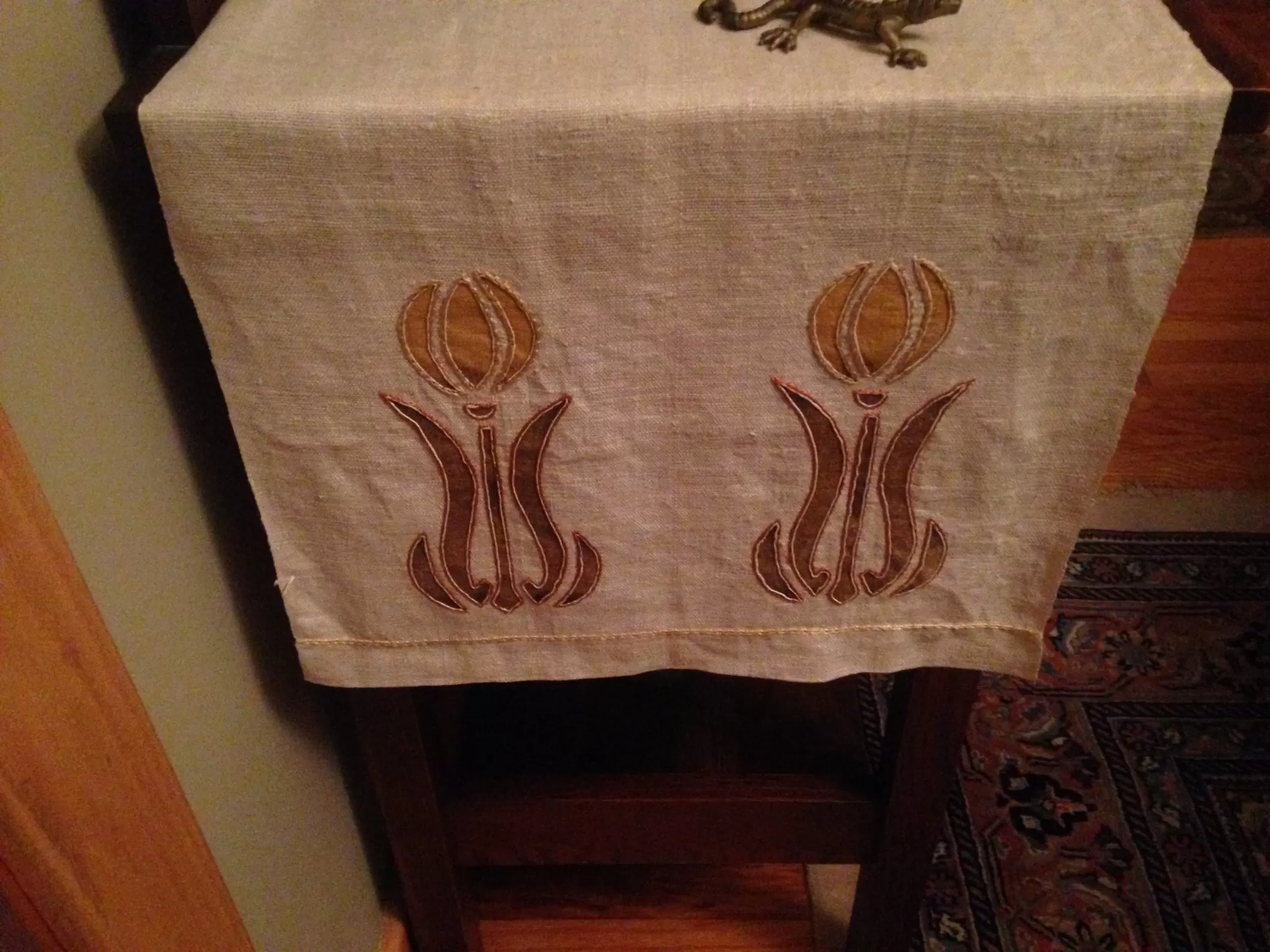Textile Care and Concern
I love Arts and Crafts textiles, and for good reason.

First, they add color to a room that brown furniture and leather can’t. Second, you can find a dozen examples of Arts and Crafts textiles for every piece of Arts and Crafts furniture or art pottery you discover. Third, they’re inexpensive, as most mall dealers don’t recognize their importance.
But many textiles have condition issues, the most common being semi-permanent creases from being folded rather than rolled when stored. So, I asked Dianne Ayres, textile expert and exhibitor at the National Arts and Crafts Conference at the Grove Park Inn, for some advice.

“If the textile is very special, such as an embroidery by Newcomb College or one you personally value as an heirloom, then the best option is to call in a professional. Often the colors in vintage textiles were not permanent and standard cleaning methods would very likely ruin the piece or greatly reduce its value. A textile conservator can give you a good prognosis for the outcome of cleaning. To find a textile conservator, check with your local museum or the American Institute for Conservation (www.conservation-us.org).
“For the vast majority of textiles, professional conservation is not warranted, so the question remains of what to do. If the textile is simply wrinkled or has fold lines, but is not stained, take a deep breath and fire up your steam iron. Remember, though, that the fibers are 100 years old and merely unfolding it may cause the brittle fibers to break, so treat your textile gently.
“Place the textile on a thick soft cloth (a couple of layers of bath towels) face down and cover it with a thin cloth, such as a piece of muslin or a sheet. Linen requires pressure to remove wrinkles. New linen can withstand the highest setting on your iron, but dial it back to a lower steam setting for your antique. And make sure your iron is not going to dribble water as you go!
“For a textile which is stained or dirty, first try simply brushing the surface with a soft bristle brush, such as a clean cosmetic brush. Spot cleaning is generally not a good idea as it will often leave a larger water stain which is even more noticeable.

“If you wish to consider washing your textile, here are some basic considerations. First, test the permanence of the fiber colors. Test each color of embroidery thread and the fabric itself. If there is a loose end on the back or the edge that you can snip off, place this in a wet cotton ball. If the color has not bled out after ten minutes, repeat the test using a soapy cotton ball. If still no bleeding, then it MIGHT be safe to wash the piece. No guarantees here, as textiles can develop a mind of their own and do surprising feats.
“Second, shrinkage is also a concern. The fabric and embroidered or appliqued areas can shrink in different ways and leave you with a misshapen piece which may or may not be remedied by blocking.
“Third, if the item has any painted areas, such as stenciling, this most likely is not permanent, and cleaning is not advised. Finally, textiles become brittle with age, even some fabrics which appear sturdy can disintegrate when washed.
“Being aware of all of these caveats, if you do decide to wash the textile and are willing to risk your textile to the whims of water, here are some suggestions:
“Use lukewarm distilled water and mild soap (never detergent) in a tub large enough so that the textile can lay flat without folding or bunching.
“Rinse completely and gently, again with distilled water.
“To pick up, place a net underneath your textile or, at a minimum, place your hands underneath with your fingers spread out to distribute the weight of the wet textile.
“Never twist or wring an antique textile. Transfer it to a clean towel and roll it loosely to help absorb excess water.
“Lay it flat to dry on a drying screen, so that air can circulate around it.
“If you need to press the textile, lay it on a thick soft cloth face down and as detailed above, iron on the back side.

“Ideally textiles should be stored flat, but if this isn’t feasible, roll it on a tube. For valuable textiles, invest in archival quality storage rolls, tissue paper and boxes from a source such as Gaylord Archival at http://www.gaylord.com/
“Some textiles simply cannot be cleaned and the stains may persist. These should be considered a part of the textile’s history, and remind us that textiles are an essential part of creating a comfortable, cheerful, friendly Arts and Crafts home.”
To visit Dianne Ayres’ website, please go to: www.TextileStudio.com.
